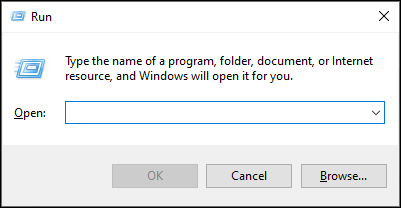Common Run commands to access various Windows settings and apps
There are a lot of different windows for configuring various settings in Windows. Unfortunately, finding the right window is not always easy. The Windows Settings menu often buries settings windows several layers deep, and they are often moved between major Windows updates, so it can be hard to find them. The Start menu search functionality isn’t always consistent or reliable, especially on Windows Server, and even the Windows Settings search can be hit or miss.
For a consistent way to access many settings and apps regardless of your Windows version, you can use a command prompt or the Run dialog box.
Opening the Run dialog box
There are two main ways to open the Run dialog box:
- Press Win + R on your keyboard, or
- Press Win to open the Start menu, type
Run, and pressEnter.
The Run dialog box will look something like this:

Opening a command prompt
Alternatively, you can open a command prompt, such as cmd or PowerShell.
Here are two ways to do that:
- Press Win + X to open the Windows X menu, then i to open PowerShell (use A instead to open a PowerShell Admin console).
- Press Win to open the Start menu, type
cmdorPowerShell, and pressEnter.
Common Run commands
With either a command prompt or the Run dialog box open, type in one of the following commands and press Enter to open the corresponding Windows setting or app.
Note: If using a command prompt, it may need to be running As Admin to open some of these settings windows.
A few commands only work from the Run dialog box and are marked as (Run only).
| Command | Description |
|---|---|
| . | Open current user folder (Run only) |
| appwiz.cpl | Programs and Features |
| C: (or any file or directory path) | Open the specified file or path (Run only) |
| certlm.msc | Certificate Manager (Local Computer) |
| certmgr.msc | Certificate Manager (Current User) |
| charmap | Character Map |
| cleanmgr | Disk Cleanup |
| cmd | Command Prompt |
| compmgmt.msc | Computer Management |
| control | Control Panel |
| control admintools | Administrative Tools |
| control desktop | Personalization |
| control folders | File Explorer Options |
| control keyboard | Keyboard Properties |
| control mouse | Mouse Properties |
| control printers | Printers and Faxes |
| control schedtasks | Task Scheduler |
| control userpasswords2 | User Accounts |
| control /name Microsoft.NetworkAndSharingCenter | Network and Sharing Center |
| control /name Microsoft.PowerOptions | Power Options |
| control /name Microsoft.System | System |
| control /name Microsoft.WindowsUpdate | Windows Update |
| desk.cpl | Display Properties |
| devmgmt.msc | Device Manager |
| diskmgmt.msc | Disk Management |
| dsa.msc | Active Directory Users and Computers |
| dxdiag | DirectX Diagnostic Tool |
| eventvwr.msc | Event Viewer |
| explorer | Windows Explorer |
| firewall.cpl | Windows Firewall |
| gpedit.msc | Local Group Policy Editor |
| inetcpl.cpl | Internet Properties |
| inetmgr | IIS Manager (if installed) (Run only) |
| logoff | Log out of Windows without confirmation |
| lusrmgr.msc | Local Users and Groups |
| magnify | Magnifier |
| main.cpl | Mouse Settings |
| mdsched | Windows Memory Diagnostic |
| mmc | Microsoft Management Console |
| mmsys.cpl | Sound Properties |
| mrt | Malware Removal Tool |
| msconfig | System Configuration |
| msinfo32 | System Information |
| mstsc | Remote Desktop Connection |
| ncpa.cpl | Network Connections |
| netplwiz | User Accounts |
| osk | On-Screen Keyboard |
| perfmon.msc | Performance Monitor |
| powercfg.cpl | Power Options |
| powershell | Windows PowerShell Console |
| psr | Steps Recorder |
| pwsh | PowerShell Core Console (if installed) |
| regedit | Registry Editor |
| resmon | Resource Monitor |
| secpol.msc | Local Security Policy |
| services.msc | Services |
| shell:appsFolder | Applications folder (see installed apps) (Run only) |
| shell:desktop | Desktop folder (Run only) |
| shell:downloads | Downloads folder (Run only) |
| shell:sendto | SendTo folder of the current user (Run only) |
| shell:common sendto | SendTo folder for all users (Run only) |
| shell:startup | Startup folder of the current user (Run only) |
| shell:common startup | Startup folder for all users (Run only) |
| shutdown /r /t 0 | Restart Windows without confirmation |
| shutdown /s /t 0 | Shut down Windows without confirmation |
| snippingtool | Screenshot Snipping Tool |
| sysdm.cpl | System Properties |
| taskmgr | Task Manager |
| temp | Temp folder of Windows (Run only) |
| %temp% | Temp folder of the current user (Run only) |
| winver | About Windows |
| wscui.cpl | Security and Maintenance |
This blog article was inspired by this LinkedIn post which shows how to define many of these in a PowerShell function that can be used to search for the command you want.
Conclusion
I hope you find this list of commands useful. If you have any other commands that you find valuable, please share them in the comments below and I might add them to this list.
Happy running!

Leave a Comment
Your email address will not be published. Required fields are marked *